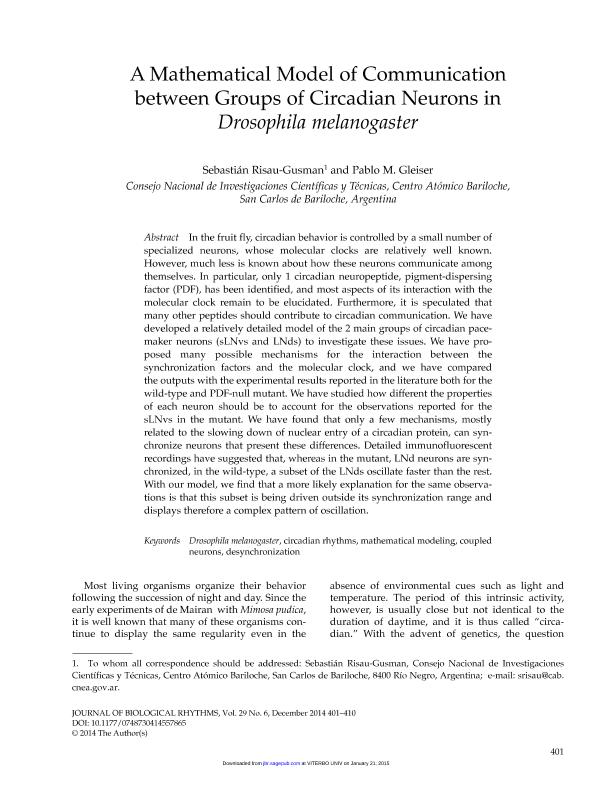Artículo
A Mathematical Model of Communication between Groups of Circadian Neurons in Drosophila melanogaster
Fecha de publicación:
11/2014
Editorial:
Sage Publications
Revista:
Journal of Biological Rhythms
ISSN:
0748-7304
Idioma:
Inglés
Tipo de recurso:
Artículo publicado
Clasificación temática:
Resumen
In the fruit fly, circadian behavior is controlled by a small number of specialized neurons, whose molecular clocks are relatively well known. However, much less is known about how these neurons communicate among themselves. In particular, only 1 circadian neuropeptide, pigment-dispersing factor (PDF), has been identified, and most aspects of its interaction with the molecular clock remain to be elucidated. Furthermore, it is speculated that many other peptides should contribute to circadian communication. We have developed a relatively detailed model of the 2 main groups of circadian pacemaker neurons (sLNvs and LNds) to investigate these issues. We have proposed many possible mechanisms for the interaction between the synchronization factors and the molecular clock, and we have compared the outputs with the experimental results reported in the literature both for the wild-type and PDF-null mutant. We have studied how different the properties of each neuron should be to account for the observations reported for the sLNvs in the mutant. We have found that only a few mechanisms, mostly related to the slowing down of nuclear entry of a circadian protein, can synchronize neurons that present these differences. Detailed immunofluorescent recordings have suggested that, whereas in the mutant, LNd neurons are synchronized, in the wild-type, a subset of the LNds oscillate faster than the rest. With our model, we find that a more likely explanation for the same observations is that this subset is being driven outside its synchronization range and displays therefore a complex pattern of oscillation.
Archivos asociados
Licencia
Identificadores
Colecciones
Articulos(CCT - PATAGONIA NORTE)
Articulos de CTRO.CIENTIFICO TECNOL.CONICET - PATAGONIA NORTE
Articulos de CTRO.CIENTIFICO TECNOL.CONICET - PATAGONIA NORTE
Citación
Risau Gusman, Sebastian Luis; Gleiser, Pablo Martin; A Mathematical Model of Communication between Groups of Circadian Neurons in Drosophila melanogaster; Sage Publications; Journal of Biological Rhythms; 29; 6; 11-2014; 401-410
Compartir
Altmétricas




